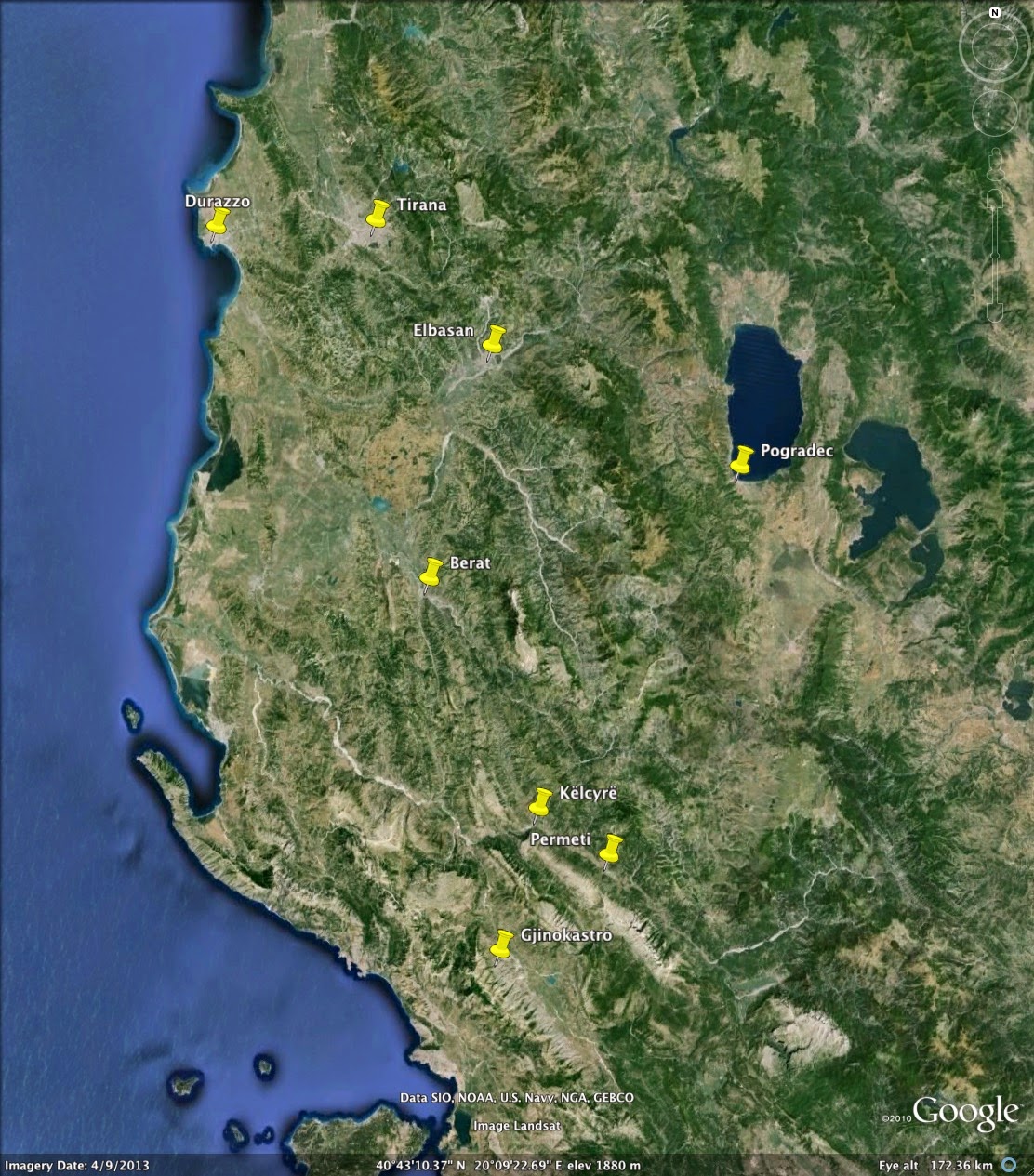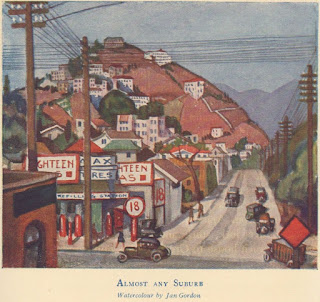Jan and Cora Gordon a Century Ago
What were Jan and Cora Gordon doing a century ago?
Well, they were busy rebuilding their careers as artists following the war.
Jan Gordon had an exhibition under the title "War and Peace" at the Little Art Rooms, Duke Street, London. P.G. Konody, Jan Gordon's old mentor at "The Observer" wrote:
"He, too, has been attracted by the witchery of the "Dazzleship" which seems to draw every painter - every painter, at least, who has as pronounced a feeling for definite form, effective pattern, and emphatic colour as Lieut. Gordon. When he recorded his impressions of Serbia, at the time when he was doing Red Cross service with the defeated Serbian armies, he embodied his love of definition and bright colour in a series of drawings, some of which figure in the present show. That his preoccupation with broad decorative effects does not preclude subtle observation of significant details is proved by such touches as the nervous action of the hand holding a cigarette in the character study, "Albanian Merchants in Scutari." "Serbian Retreat in the Ipek Pass" strikes a grim dramatic note. As far as his art is concerned Lieut. Gordon's trip to Serbia was an accident ; he is the last man to find it necessary to travel far afield in search of the picturesque. He finds it wherever he happens to be - in a "Cornish Garden" or "A Farmyard," and particularly in "Regent's Park."
This was a solo show, with Marthe Troly-Curtin reporting:
"I have an idea that many of the fancy costumes worn at the Razzle-Dazzle Ball on the 12th were inspired by the show of dazzle ships which Jan Gordon, Lieutenant R.N.V.R., is having at the Little Art Rooms in Duke Street. I searched there in vain for some works by Jo Gordon too, as generally Jan and Jo are as inseparable in art as they are in life but "Jo" explained quaintly to me that they are trying the experiment of being "cats that walk on their lone" as regards picture shows only!"

A useful recent reference on these dazzle designs and their influence in popular culture is James Taylor's 2016 "Dazzle: Disguise and Disruption in War and Art." He states that: "in the course of the First World War, a collision of naval strategy and the nascent modern art movement, led to some two thousand British ships going to sea as the largest painted modernist “canvases” in the world covered in abstract, clashing, decorative, and geometric designs in a myriad of colors."
Jan Gordon was also working as an art critic in 1919, as seen for example in his commentary on John Singer Sargent's popular painting "Gassed" for the Athenaeum (Jan was not popular with Virginia Woolf at the time). There were also parties, as hinted at by Marthe Troly-Curtin, writing in "The Sketch."
1920 would see the start of a long series of painting journeys in Europe and the USA, resulting in a highly fruitful new phase in the artistic and literary careers of Jan and Cora Gordon. Their first journey would be to the warmth of southern Spain.
References
- Jan Gordon: Dazzle Camouflage in Nature and War March 11, 2014
- Jan Gordon and the Dazzle-Painting of Ships, March 25, 2014
- "Dazzle-Painting in War-Time", May 18, 2014
- Jan Gordon on John Singer Sargent's "Gassed", February 22, 2015
- Jan Gordon and the "Dazzleship" at the Little Art Rooms, 1919, March 06, 2015
- Virginia Woolf on Jan Gordon, 1919, February 03, 2016
- Jan Gordon and WWI Dazzle Ship Painting: a new book by James Taylor, December 03, 2016
- 1919: "Jan and Jo Gordon, of Serbian, as well as of artistic fame", May 03, 2018
- A Jan Gordon Dazzle Ships Exhibition 1919, May 05, 2018
Well, they were busy rebuilding their careers as artists following the war.
Jan Gordon had an exhibition under the title "War and Peace" at the Little Art Rooms, Duke Street, London. P.G. Konody, Jan Gordon's old mentor at "The Observer" wrote:
"He, too, has been attracted by the witchery of the "Dazzleship" which seems to draw every painter - every painter, at least, who has as pronounced a feeling for definite form, effective pattern, and emphatic colour as Lieut. Gordon. When he recorded his impressions of Serbia, at the time when he was doing Red Cross service with the defeated Serbian armies, he embodied his love of definition and bright colour in a series of drawings, some of which figure in the present show. That his preoccupation with broad decorative effects does not preclude subtle observation of significant details is proved by such touches as the nervous action of the hand holding a cigarette in the character study, "Albanian Merchants in Scutari." "Serbian Retreat in the Ipek Pass" strikes a grim dramatic note. As far as his art is concerned Lieut. Gordon's trip to Serbia was an accident ; he is the last man to find it necessary to travel far afield in search of the picturesque. He finds it wherever he happens to be - in a "Cornish Garden" or "A Farmyard," and particularly in "Regent's Park."
This was a solo show, with Marthe Troly-Curtin reporting:
"I have an idea that many of the fancy costumes worn at the Razzle-Dazzle Ball on the 12th were inspired by the show of dazzle ships which Jan Gordon, Lieutenant R.N.V.R., is having at the Little Art Rooms in Duke Street. I searched there in vain for some works by Jo Gordon too, as generally Jan and Jo are as inseparable in art as they are in life but "Jo" explained quaintly to me that they are trying the experiment of being "cats that walk on their lone" as regards picture shows only!"

From Jan Gordon's 1918 article in Land & Water magazine
A useful recent reference on these dazzle designs and their influence in popular culture is James Taylor's 2016 "Dazzle: Disguise and Disruption in War and Art." He states that: "in the course of the First World War, a collision of naval strategy and the nascent modern art movement, led to some two thousand British ships going to sea as the largest painted modernist “canvases” in the world covered in abstract, clashing, decorative, and geometric designs in a myriad of colors."
Jan Gordon was also working as an art critic in 1919, as seen for example in his commentary on John Singer Sargent's popular painting "Gassed" for the Athenaeum (Jan was not popular with Virginia Woolf at the time). There were also parties, as hinted at by Marthe Troly-Curtin, writing in "The Sketch."
1920 would see the start of a long series of painting journeys in Europe and the USA, resulting in a highly fruitful new phase in the artistic and literary careers of Jan and Cora Gordon. Their first journey would be to the warmth of southern Spain.
References
- Jan Gordon: Dazzle Camouflage in Nature and War March 11, 2014
- Jan Gordon and the Dazzle-Painting of Ships, March 25, 2014
- "Dazzle-Painting in War-Time", May 18, 2014
- Jan Gordon on John Singer Sargent's "Gassed", February 22, 2015
- Jan Gordon and the "Dazzleship" at the Little Art Rooms, 1919, March 06, 2015
- Virginia Woolf on Jan Gordon, 1919, February 03, 2016
- Jan Gordon and WWI Dazzle Ship Painting: a new book by James Taylor, December 03, 2016
- 1919: "Jan and Jo Gordon, of Serbian, as well as of artistic fame", May 03, 2018
- A Jan Gordon Dazzle Ships Exhibition 1919, May 05, 2018



Comments
Post a Comment